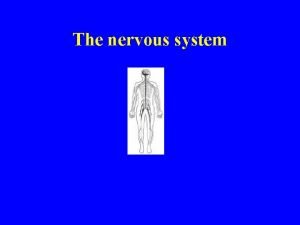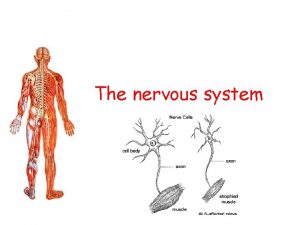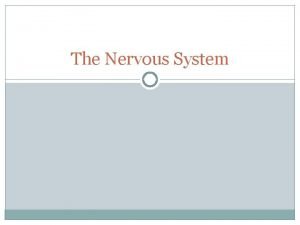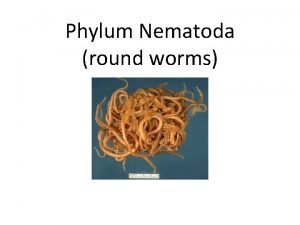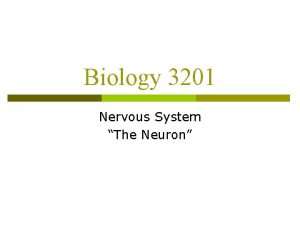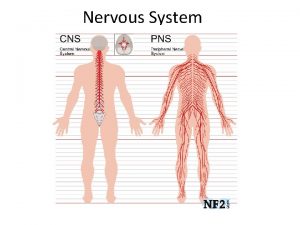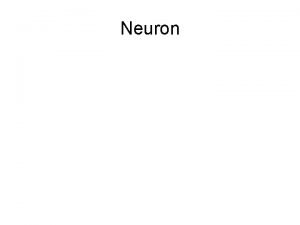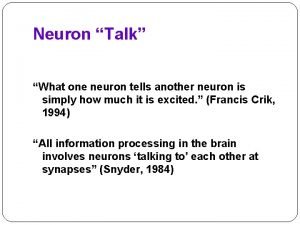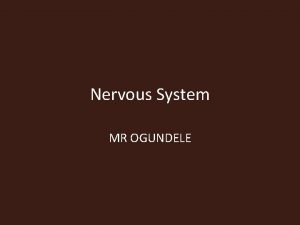The Nervous System The Neuron The neuron is






















- Slides: 22

The Nervous System

The Neuron • The neuron is the basic unit of the nervous system • Central Neurons in CNS • Peripheral Neurons in PNS


The Peripheral and Central Nervous Systems ®The peripheral nervous system carries information to and from the nervous system ®The somatic nervous system is the part of the peripheral nervous system that carries information to skeletal muscles

The Peripheral and Central Nervous Systems • The sympathetic nervous system is the part of the autonomic nervous system that becomes most active during emergency situations

The Peripheral and Central Nervous Systems • The parasympathetic nervous system is the part of the autonomic nervous system that controls the ongoing maintenance processes of the body

Figure 2. 8 The Basic Divisions of the Nervous System

Five Principles of Brain Organization 1. The hindbrain, midbrain, and forebrain each involve several brain regions that carry out different types of information processing 2. There are identifiable neural pathways projecting from one area to the next

Five Principles of Brain Organization 3. Each part of the brain projects to the next in an orderly fashion creating organized regions that can be mapped 4. The brain is hierarchically organized 5. The brain systems are organized so that one side of the brain controls the other side of the body

Figure 2. 11 The Hindbrain

The Midbrain • The midbrain receives afferent signals from other parts of the brain and relays the information to a more complex part of the brain

The Forebrain • The forebrain is the most complicated and advanced of the three divisions of the brain • The thalamus sends information to other parts of the brain • The hypothalamus affects many complex behaviours

Figure 2. 12 The Forebrain

The Forebrain • The limbic system is an interconnected group of structures that influences emotions and memory • The hippocampus is involved in new learning • The amygdala is involved in emotional control

Figure 2. 13 Principal Structures of the Limbic System

The Forebrain • The basal ganglia controls movement and posture • The corpus callosum provides crosshemisphere connections

The Cortex • The cortex is divided into a series of lobes

The Cortex • The frontal lobe is concerned with directing thought processes • The parietal lobe integrates visual input • The occipital lobe processes visual input • The temporal lobe is important for language comprehension

Figure 2. 14 The Cortex and the Lobes of the Brain

Monitoring Neural Activity • Single-unit recording measures activity in individual neurons • Electroencephalography (EEG) measures electrical activity in the nervous system

Monitoring Neural Activity • CT scans are computer-enhanced X- rays • PET tracks radioactive markers that have been injected into the bloodstream

Monitoring Neural Activity • MRI uses magnetic fields • f. MRI measures brain activity as it takes place
 Neuronal pool
Neuronal pool Fundamentals of the nervous system and nervous tissue
Fundamentals of the nervous system and nervous tissue Processes of a neuron
Processes of a neuron Nervous system and digestive system
Nervous system and digestive system Endocrine system vs nervous system
Endocrine system vs nervous system Mechanism of hormone action
Mechanism of hormone action Adh function
Adh function Chemical messengers of the nervous system
Chemical messengers of the nervous system Roundworms segmentation
Roundworms segmentation The nervous system is made up of
The nervous system is made up of Primary functions of the nervous system
Primary functions of the nervous system Nervous system learning objectives
Nervous system learning objectives Chapter 7 the nervous system
Chapter 7 the nervous system What is stimuli in nervous system
What is stimuli in nervous system Objectives of nervous system
Objectives of nervous system Autonomic nervous system visceral
Autonomic nervous system visceral Sympathetic nervous system def
Sympathetic nervous system def The spinal nerves
The spinal nerves Sns pg
Sns pg The nervous system brain scienstructable
The nervous system brain scienstructable Autonomic nervous system skeletal muscle
Autonomic nervous system skeletal muscle Nematoda
Nematoda Phylum arthropoda characteristics
Phylum arthropoda characteristics









